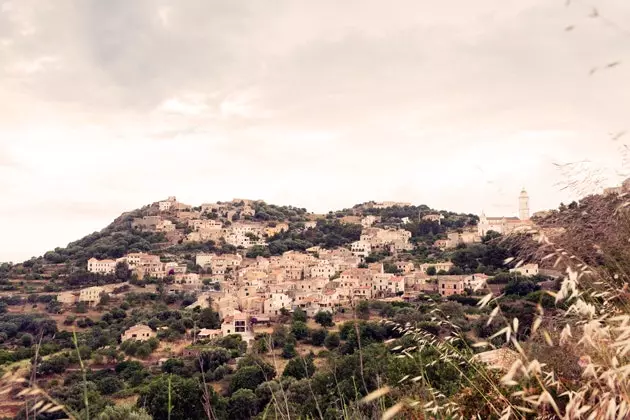
Corsica: the island with the most suitors
Imagine that I ask you how your day was and you answer me with a gesture. You close your right fist and raise your thumb. Just like the shape of your hand is that of the map of Corsica . And in this way, better than with paper and pen, the Corsicans manage to explain to foreigners any aspect of their island. How many kilometers are there from south to north, that is, from the folds where the diviners of the future they read the lines of life to the end of the big toe ? 183. How long does it take to travel from west to east, that is, from wrist to knuckle snatch ? 2 hours . That at what exact point is this or that town? A the height of the index finger, ring finger, heart ... or of thumb , if we are talking about its less inconspicuous outcrop, the northern cape of Corsica, Cap Corse.
The whole fist, that is to say the corsica island , has an area of almost 9,000 km2 (more or less like the entire province of Almería); It is just above the island of Sardinia and, like its 'Italian sister', it has almost always been the most requested at the dance. Not only because it is beautiful (the Greeks did not call it kalliste, the most beautiful, by chance), but –and above all– because of its location, a authentic candy to control the Mediterranean trade.
Romans, Pisans, Genoese, Spanish and French... throughout its history it passed arm in arm of suitors from here and there, and incorporated a little bit of each of them into his portrait. That is why, sometimes, the island misleads. Unsettle. Especially when walking you run into peeling doors and squares with Baroque churches and Italian cafes , or when you listen to a couple of teenagers talking in their dialect, the Corsican –on the mend as one more token of his pride independentista (and that are interspersed with words in French, I imagine tacos and neologisms) – much closer to Dante's language than to Voltaire's.
And it is that, put to pull of classics, Balzac already advanced it: “ Corsica is the french island warming up in the italian sun ”. I read it over and over again in brochures and travel books. Literal. Not only because his personality is very more mediterranean but, more plausibly, because of its geography (just 90 kilometers from the Genoese coast) and its climate (long, dry summers, an average of 12ºC and 2,700 hours of sunshine per year).
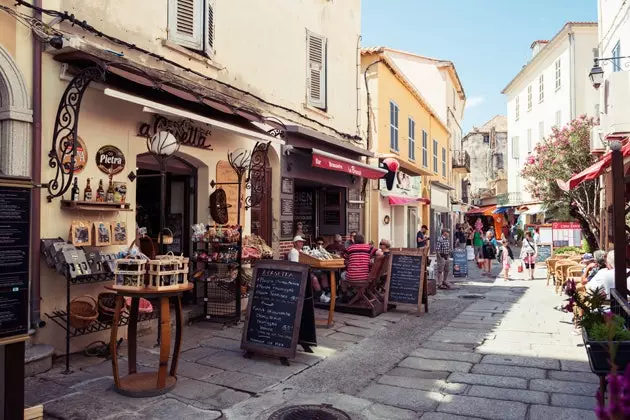
Clemenceau Street
With everything and with that, Corsica is not Italy. Not France. Corsica is Corsica. And mountain. Two irrefutable axioms that are learned here before the table of one. Because although its 1,000 kilometers of coastline go a long way –for sandy beaches , for cavernous coves and for marinas– and although they are the carrot that hooks many of its visitors, their island is for Corsicans, above all that, mountain . It does not matter that there are no very high peaks (the average is 500 meters, and the summit, the Belt , it is only 2,170 meters high), the mountain occupies two thirds of its surface and has marked many chapters of its history and many traits of its character.
I land on Bastia to take a tour of the north of the island. This is not the capital, but it is the second largest city and – by landslide – the more cosmopolitan , thanks to a bustling fishing and commercial port, which was for centuries the gateway to all the new developments on the continent. With a predictable rivalry, Ajaccio , in the south, “the other Corsican metropolis” fights back, boasting of being the capital. But what this island is really known for is being the cradle of one of the most famous characters in contemporary history . Make bets: short, arm in a sling and ego inversely proportional to his centimeters. Last name Bonaparte.
Not from the Waterloo loser, but from his nephew, Napoleon III , represented as a consul, is the statue that presides over the Plaza de Saint-Nicolas in Bastia, one of the largest esplanades in Europe (300 m x 90 m), open to the sea between palm trees and terraces (and, beware, less than 50 kilometers from the island of Elba) .
The calendar marks the busiest day in red. Around its nineteenth-century kiosk, the Sunday flea and antique market stalls are set up . With the pretense of finding 'oil', I search between an art deco coffee set, some sheets embroidered with anonymous initials and a black and white photo album that was the only thing that nobody collected from some grandmother's inheritance... Objects that also could find in Passé composé, a charming place of sale and exchange of second hand and knickknacks with tea room , on the street Napoleon , the pedestrian street where art galleries and trendy shops – hipster barbershops, gourmet shops or colorful boutiques – have been emerging along with lifelong businesses.
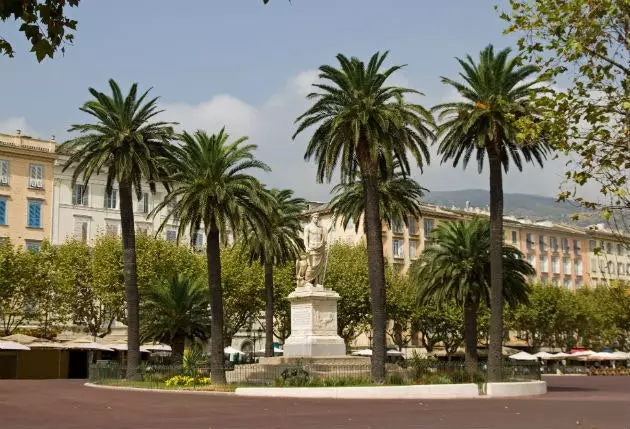
Napoleon III is the statue that presides over the Saint-Nicolas square
The shoe store albert cohen It is one of them. He still retains his surname sign from the times when Corsica was under the siege of Nelson (1774-76). Those in which the admiral here lost the sight of his right eye, and those in which anyone who passed in front of the oratory of the Brotherhood of the Immaculate Conception (recognizable by the mosaic of stones on the floor) was obliged to rinse his throat and sing the 'God save the king ', the song with which the colonies recognized the British king as their head of state.
Napoleon Street ends at the Plaza del Ayuntamiento, where every morning the market takes place in front of the church doors Saint John Baptist . It is the largest on the island and, although its façade, with two symmetrical bell towers, is hidden by the fishermen's houses and behind the colored boats of the old port (the vieux port) in the foreground, the stamp makes up the most sent postcard from Bastia. Colors are the protagonists . Also from my cone, which I buy at Café Raugi, a Artisan ice cream parlor that offers different and exotic flavors such as Bront's pistachio (a town on the island) , salted butter, or cédrat (a Corsican fruit similar to lemon, at the time, my choice) , which melts before climbing the steps of Saint-Charles leading to the citadel.
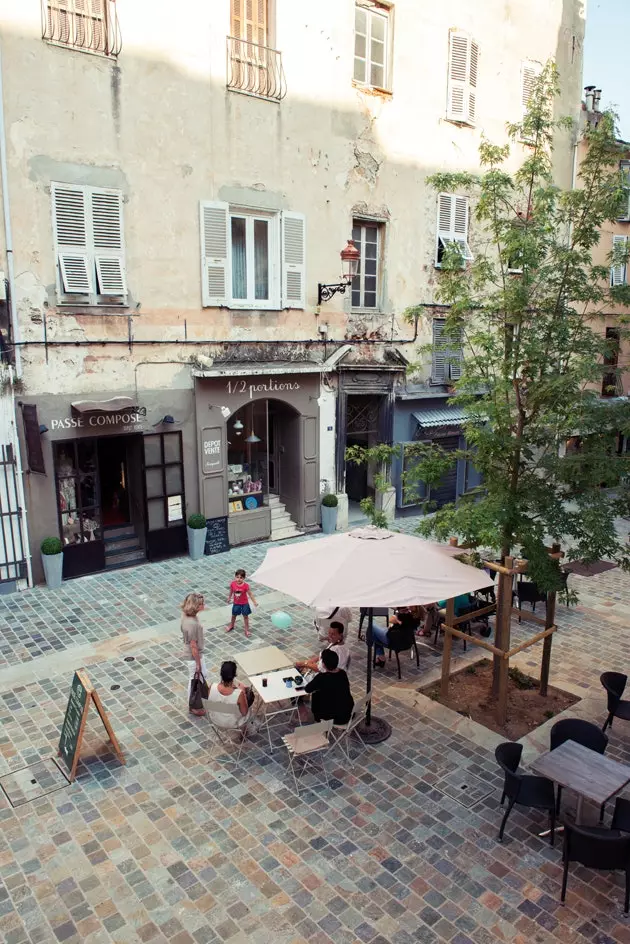
Napoleon Street in Bastia
The central core of the old fiefdom of the Genoese is the place du Donjon. Terraces and restaurants , As the Chez Vincent , give views of the docks, and some religious buildings also survive around it, such as the cathedral of Saint Marie (next to him I discover a plaque that assures that Victor Hugo lived there) and the oratory of Saint Croix , the only rococo in France, which keeps the image of the black christ , to which the fishermen have great veneration and take every three years in procession.
With the same devotion as them, I set course for Cap Corse , a peninsula with very peculiar characteristics, which has its own personality. It is a succession of Genoese towers (a total of 67 along the coast, so called because they were built by the Genoese to protect themselves from invasions) ; seafaring towns (although unlikely, this was one of the few areas of the island where they lived from fishing) and colonial houses (built by the 'Americans', emigrants who left Corsica in the 19th century, headed for Peru, Mexico and Venezuela and returned rich) .
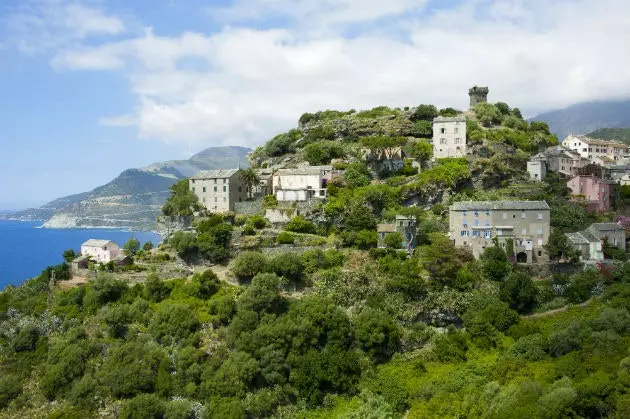
The wildest west, villas overlooking cliffs like Nonza
Cypresses, maquis (the low vegetation characteristic of Corsica, which combines rockrose, myrtle and heather, among other plants), pines, orchids and olive trees... my car window frames a 100% Mediterranean landscape that meanders to the beat of the curves, with blue always as a backdrop. They are 40 kilometers long and 10 wide, which weave together a spectacular coastal road. On the east side, and with a softer relief, it begins with the fishing village of Erbalunga , where they like to escape Parisian bourgeois , and continue with Macinaggio, Ersa and Col de la Serra.
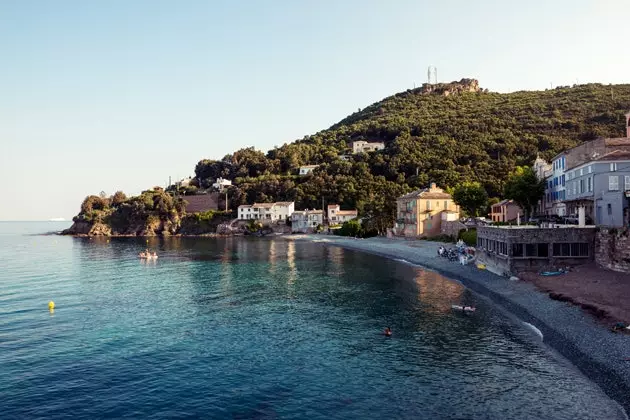
Erbalunga
West, wildest , is a succession of villas overlooking cliffs like Centuri (famous for its lobster) and nonza . It is here, in the hills of a small cape town, Patrimonio, where the most famous wines of the island are born . The –many– hours of sunshine, the calcareous soils and the hand of the local winemakers give correct rosés, whites (with the vermentino variety) and, especially red (from the nielluccio varietal, similar to Tuscan sangiovese and the main grape of the denomination of origin), which I taste in the small wineries, on the way to Saint Florent , an elegant vacation town.
The "Saint-Tropez of Corsica" is nothing more than a promontory with a citadel, a historic center of medieval alleys and a marina, full of bars and restaurants. But, merits of its own aside, Saint-Florent is also the sea gate to the desert of the sour , a protected natural area which extends about 30 kilometers, between Saint Florent and the mouth of the Ostriconi. His name is cheater. There is no trace of dunes, oases or palm trees, but there is wild landscapes, sharp rocky ridges, olive trees, maquis and hats off beaches . those of Saleccia and mud , they have everything a beach should have: fine and toasted sands, waters so transparent like a mirror and forests to explore by bicycle, on foot or on horseback.
By sea you arrive in speedboat or on the catamarans (the famous 'popeyes') in a few minutes from the port of Saint-Florent; by land, in an off-road vehicle to avoid the roughness of the road in the last sections or on foot, following hiking routes of different duration and intensity. My hedonistic side wins the pulse (again), and after taking a memorable swim on the beach in Saleccia , worthy of an advertisement for Dominican rum, return to Saint-Florent, to continue towards bald.
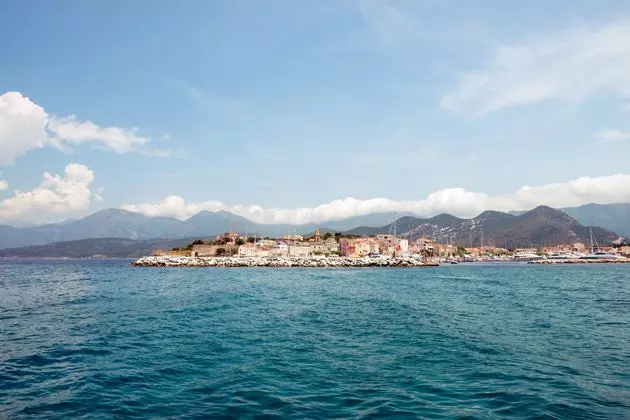
Villa of Saint-Florent
at the gates of Ile Rousse find the Saleccia Botanical Park , a seven-hectare park dedicated to Corsican and Mediterranean vegetation that was recovered by Isabelle's family, its current owner, for three decades, after the fire that devastated it in 1974, until it became what it is today: a wild, authentic and little –or not at all– pretentious place. Quite a discovery.
I walk through its rose garden, learn about botany by reading the descriptions of the plants and watch an entire family playing with the animals on their small farm. Workshop after workshop, shop after shop, with the excuse of following the craftsmen's road (Strada di l'Artigiani) of the Balagne , the province known as “ the corsican garden ”, I stop at some of the most picturesque towns. Some have the title, like the San Antonino tightrope walker , in the list of “ the most beautiful villas in France ” (it is the only one on the island present in the ranking), cobbled and steep, and with spectacular views of the beach and the mountains.
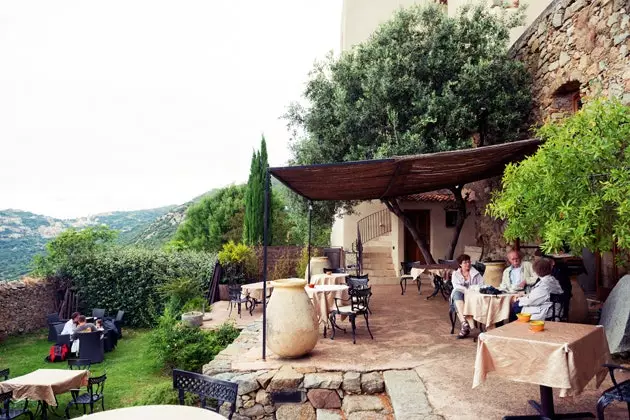
U Palazzu hotel restaurant
Others, like pigna, They do not appear in any official list, but they do appear in the favorites of many Corsicans (and in my personal list). It is an example of village rehabilitated by young artisans . It is all pedestrian (in fact, carbon dioxide is prohibited in the entire town), it has an air bohemian and chic at the same time, and full of little corners that cry out to open a bottle of wine and toast under any pretext. Your church looks more Mexican than French , its square is always full of children running around, and its photogenic streets that go up, with flowers and kittens always ready for the click.
Something that seems to be a constant in the area, since it was on the neighbor's beach lumio (the town preferred by the inhabitants of the area to see the sunsets) where a photographer discovered the voluptuous beauty of a young girl named Laetitia Casta . Even more famous than the top is another Corsican citizen. Or at least that is what they say in Calvi, where the audio guide with which I follow the visit to the citadel makes me stop in front of the “ house where Christopher Columbus was born ”. Yet another place that scores the point of having seen the admiral born. Although there is no record to confirm it, at that time Corsica belonged to Genoa and what is known is that his parents lived here at that time.
Today the citadel does not have much activity. Life in the city that kick-started tourism on the island takes place in the lower part: on streets like the one on the Republish , with restaurants and shops, in a marina with yachts and terraces serving the freshest fish , in a six kilometer beach, with palm trees and beach bars .And... even on a train that, close to it, runs along the coast to Île Rousse: up to the knuckle of the index finger.
* This article is published in the Condé Nast Traveler magazine for October number 77. This issue is available in its digital version for iPad in the iTunes AppStore, and in the digital version for PC, Mac, Smartphone and iPad in the virtual newsstand by Zinio (on Smartphone devices: Android, PC/Mac, Win8, WebOS, Rim, iPad) . Also, you can find us on Google Play Newsstand.
*** You may also be interested in...**
- Expert Guide to Corsica: Wonder in the Mediterranean
- 20 reasons to love Sardinia - 42 things you have to do in France once in your life
- Guide to travel in France
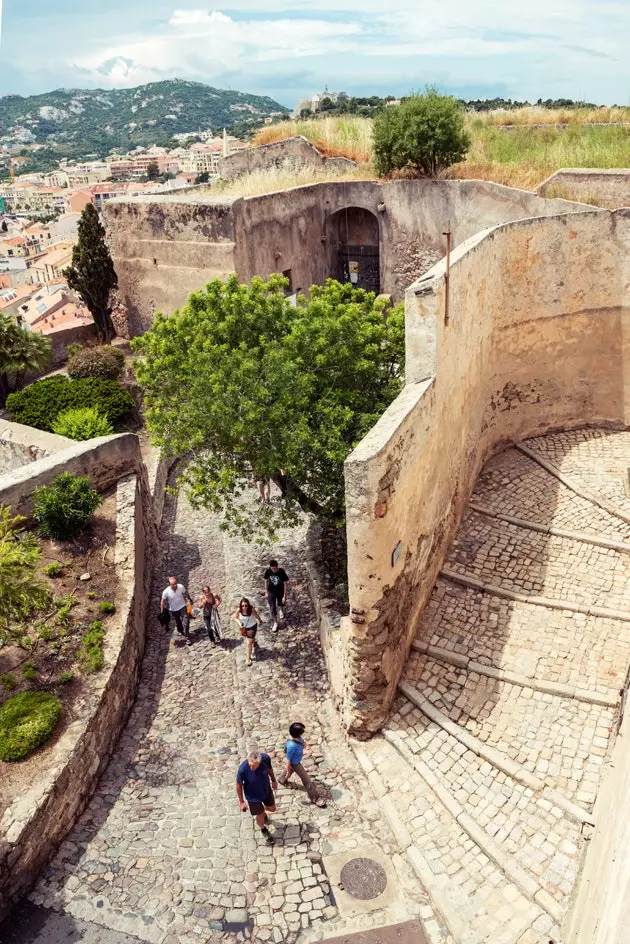
Citadel of Calvi
